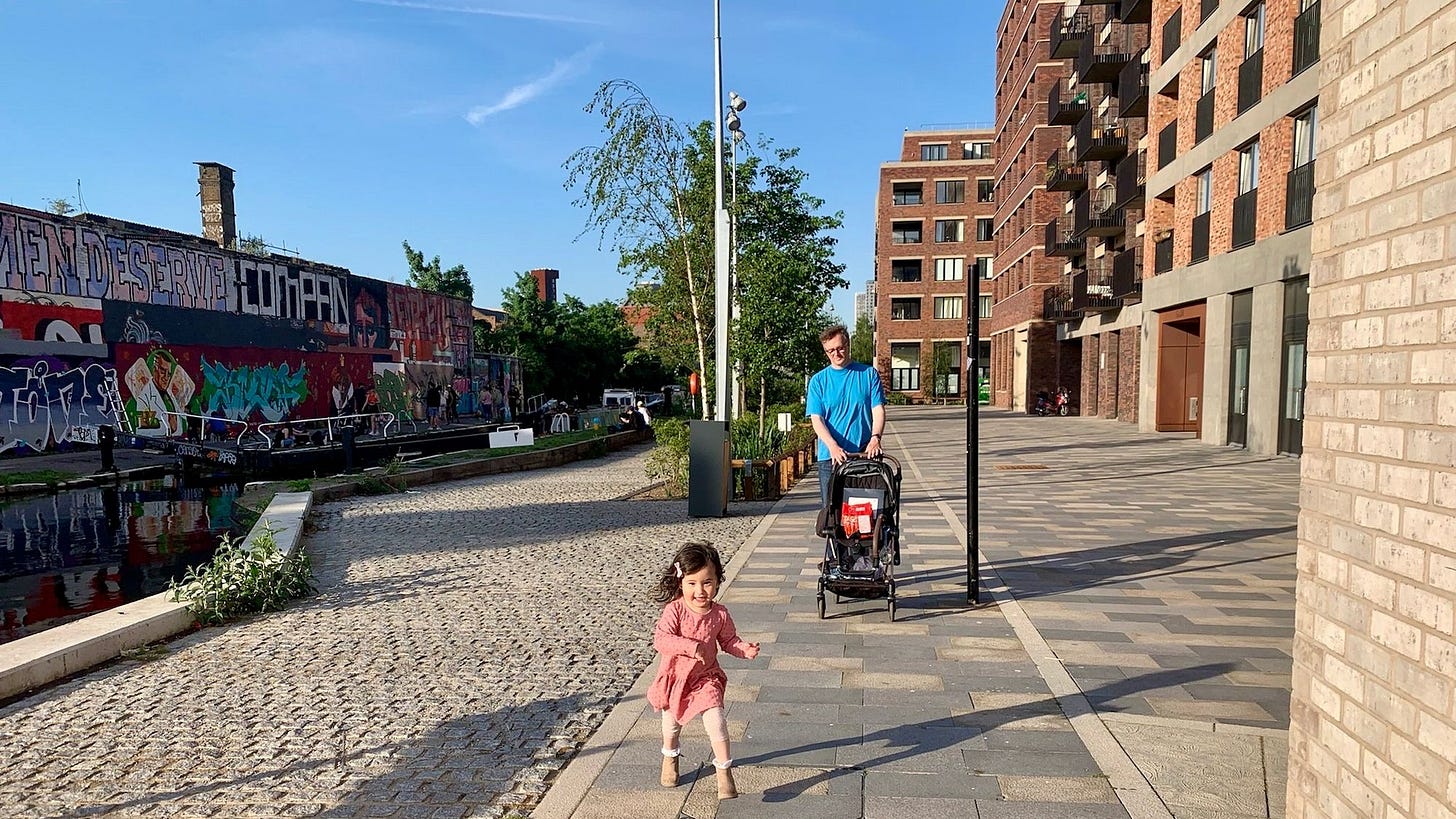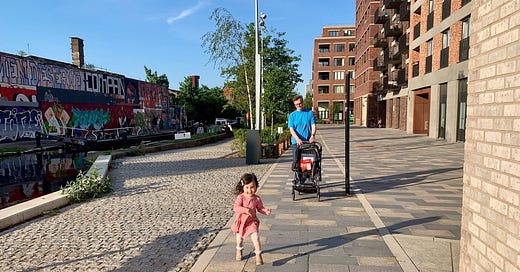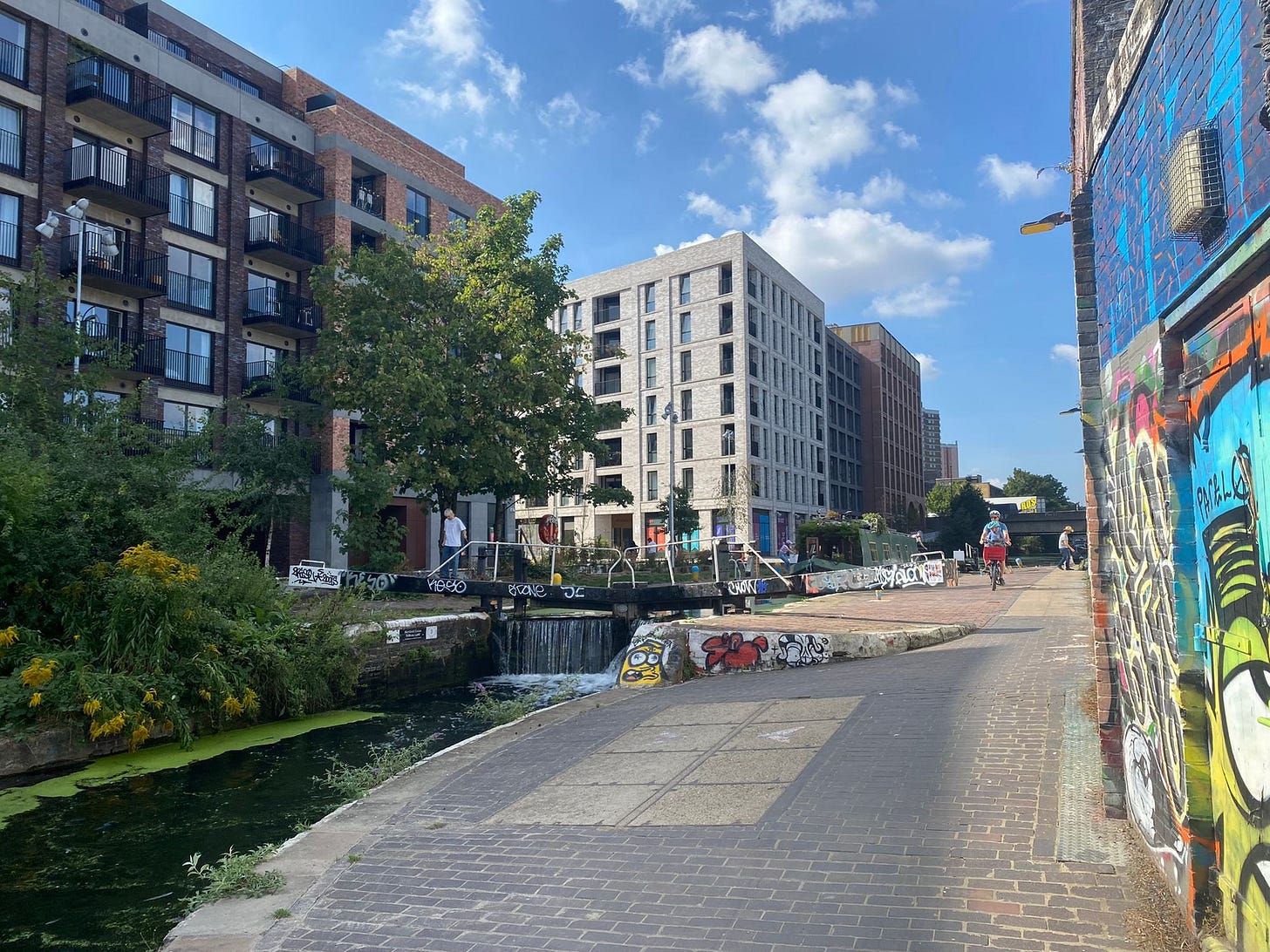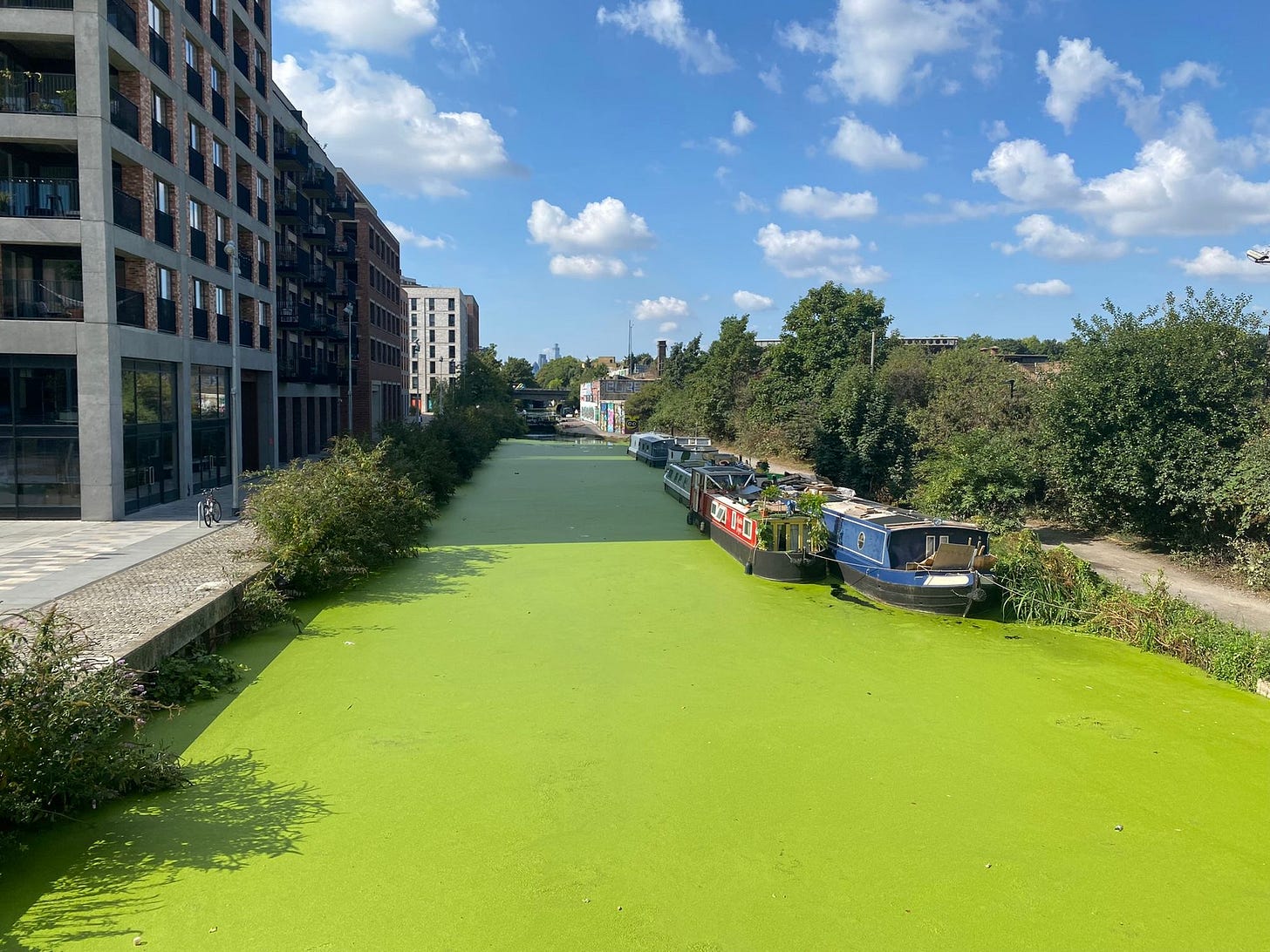Moving to...Fish Island
Welcome to my island...Fish Island. What's it like to live in Fish Island? Hackney Wicks quieter and more family-oriented sister.

This is part of the usual Moving to... series, but this time I'm writing from lived experience! Fish Island is our home. And unlike some of the other places I’ve profiled, this isn’t about a weekend wander and a speculative Rightmove scroll—this is where we unpacked boxes, wrangled a buggy into a lift, and learned which nearby café does a babyccino that won’t end in tears.
Like much of this blog, I’ve been trying to write this post for years, but it’s never been quite right. Maybe because, if I’m honest, I don’t love love Fish Island. I love our flat, and it’s been great for Violet, but the area was always a compromise. It was also, inevitably, shaped by Covid.
Fish Island isn’t perfect—and I wouldn’t try to convince you otherwise. It’s a bit odd, a bit patchy, a bit isolated. It doesn’t tick every conventional box, and yet… we chose it. For specific, solid reasons that still stand up. There’s plenty to like here. For a certain kind of urban family life—the kind with bikes, canal walks, and playgrounds instead of high streets—it’s kind of ideal.
It’s also a place in flux. In just three years, it’s changed hugely. And there’s more coming. Two V&As (V&A East and V&A Storehouse), Sadler’s Wells East, two universities (UCL east and UAL), and a rumoured private secondary school (because of course there is).
So this post is part guide, part reflection. Hopefully a bit helpful, hopefully a bit funny. And if nothing else, a snapshot of what it’s like to actually live in one of London’s more confusingly named neighbourhoods.
Note: I’m not going to touch on the bigger questions of gentrification or displacement. There are better people to speak to that. This article is biased and from a very particular perspective... that of a 48-year-old dad worried about house prices, schools and quality of life—but trying his best to care about the other stuff too.
Where is Fish Island and why is it called that?
Fish Island sits just south of Hackney Wick and west of the River Lea, in that slightly ambiguous patch of East London where Tower Hamlets meets Newham and everyone pretends it's Hackney because that just sounds cooler. It’s not actually an island in the traditional sense, but it is surrounded on two sides by water—a canal to the north and river to the east—so the name isn’t entirely misleading. To the west, it's bounded by the A12!
As for the name, it’s Victorian industrial romanticism at its finest. The streets here are named after various species of fish—Roach Road, Dace Road, Bream Street—presumably by someone with a very specific hobby and too much influence in the planning department. There’s no actual evidence that this was once a thriving fishing port, but the name stuck, and now it adds a slight air of mystery to what is essentially a former warehouse district turned developer darling.
It’s the kind of name that estate agents love and taxi drivers don’t believe is real. And yet, here it is: Fish Island. Home to artists, architects, families, sourdough start-ups and the odd bemused visitor trying to get to Westfield.
Why We Chose It
To understand why we ended up in Fish Island, I need to give a bit of context—and be a little more personal than I usually would in a post about neighbourhoods and property.
Our daughter Violet was born in April 2020, right at the start of the first lockdown. My partner was also unwell for two years. We found ourselves stuck in a tiny one-bed flat in Clerkenwell that had always been a short-term solution. We’d planned to move before Violet arrived, but—like many people—life got in the way. Then Covid stretched everything out. By 2022, we were beyond ready for change.
We’d originally been looking at places like Stoke Newington or Crouch End. But house prices shot up during the pandemic as everyone raced to buy a garden. We missed the boat. We couldn’t sell our old flat in time, so our budget shrank. We just needed space—and fast.
Then, almost by accident, we saw a listing for a flat in Fish Island. It had already gone, but it put the area on our radar. We knew it a bit—some good friends live nearby, and I’d even contributed to the local planning policy—but we’d never considered it seriously.
Then we found Fish Island Village. The flats were well-designed and, crucially, within budget. We weren’t chasing perfection, just a liveable compromise. And Fish Island ticked just enough boxes: (relatively) affordable, safe, quiet, well-connected by bike, and close to good schools.
But what really sold it was the green space. Victoria Park on one side, the Olympic Park on the other, and a canal path between them. That strange blend of nature and urban grit makes the area feel unique. Years later, we still use those parks constantly. We walk, we scoot, we picnic. We do the nod of recognition with other tired-looking parents.
If things had gone differently, we might have ended up in a garden flat in Crouch End or a house in Wanstead. But they didn’t—and here we are. It’s not our forever home (probably), but it’s starting to feel like home. Which, in London, is saying something.
What It’s Actually Like
Living in Fish Island is a little like living in an architect’s sketch—attractive, intriguing, and not entirely finished. It’s oddly quiet, especially given how close you are to Westfield and the A12. That said, not all of Fish Island is equally tranquil. The western edge, nearer the A12, gets its fair share of hum and rumble, and ongoing building works have been part of daily life for over two years. One day, we assume, it will stop. And when it does, it might be the calmest bit of East London within cycling distance of Zone 1.
The area is defined—physically and psychologically—by water. Canals to the west and east, the River Lea to the south. It gives Fish Island a lovely, floaty feel and a surprising sense of detachment from the rest of London. Fewer cars. More swans. The odd paddleboarder. But it also means that getting around can be a little less direct than you’d like. That five-minute walk can become a fifteen-minute loop thanks to a missing bridge or an awkward bit of towpath.
It’s also a place of contradictions. You can walk past three different types of artisan bakery and still not find anywhere to buy bin bags. There’s a distinct lack of traditional local infrastructure—no butcher, no greengrocer, no reliable corner shop—but there are some lovely places if you know where to look. The Tuck Shop is a small but impressively curated grocery store that always seems to stock something you didn’t know you needed. There’s a brilliant bakery, a cheese shop that could bankrupt you if you’re not careful, and the occasional pop-up that turns out to be wonderful despite looking like it was furnished entirely from a skip.
It’s not a neighbourhood in the conventional sense. More like a cluster of well-designed residential buildings arranged along the canal, with bits of light industry and a few wildly overpriced cafés scattered in between. But the community is growing. We wave to neighbours, we know the dog names before the human ones, and there’s a sense that people are choosing to stay, not just pass through.
And despite the modern vibe, it’s surprisingly sleepy. The streets are rarely busy. The traffic is minimal. Even the local Deliveroo riders seem to move in slow motion. It’s peaceful in a way that can feel either calming or mildly disconcerting, depending on your mood.
Fish Island also benefits from being right next to Hackney Wick—its louder, livelier sibling. On a Friday night, Hackney Wick is buzzing with bars, breweries, and the faint whiff of something herbal in the air. And the best part? After a night out (or more likely, a single drink followed by home at 9pm), you can retreat to the quiet of Fish Island and actually get some sleep.
It’s not love at first sight, and maybe not even love at all—but it is a place that grows on you. Slowly. Persistently. Like limescale in your kettle, but nicer.
Raising a Family in Fish Island
It’s not the obvious choice. No garden, no high street, no charming Edwardian terraces. And yet, Fish Island has quietly become a magnet for young families. You see it in the buggies lined up outside the cafés, the scooter traffic on the towpaths, and the volume of children’s voices echoing around the courtyards.
Part of it is the new-build effect. Lift access, decent insulation, underfloor heating—all the things you stop taking for granted once you’ve tried to get a pram up three flights of Victorian stairs. And there’s something about living in close quarters that brings people together. Courtyards double up as playgrounds. Parents chat while wrangling toddlers. Someone always has Calpol.
But more than that, it’s the green space. Victoria Park is a short stroll away and absolutely world-class for children. Olympic Park offers wide paths, splash fountains, and a climbing wall disguised as public art. You can walk, scoot, cycle, and picnic without ever leaving the neighbourhood.
The local primary schools are good, too. We’re in the catchment for a couple of well-regarded options, and while the competition isn’t quite as fierce as in other parts of East London, there’s still a healthy amount of hand-wringing around admissions. You know, the usual.
It’s not perfect, of course. The lack of soft play, child-friendly cafés with actual changing tables, or a reliable pharmacy can be mildly exasperating. But overall, it’s a surprisingly decent place to raise small humans. Especially if you like your parenting with a side of oat milk and a passing barge.
The Changing Context
Fish Island today isn’t the same as Fish Island three years ago—and it won’t be the same three years from now. It’s a neighbourhood in motion.
The Wickside development looms large, both physically and symbolically. It’s bringing new homes, new public spaces, and a general sense that Fish Island is finally being stitched into the wider fabric of East London. And the new pedestrian bridge connecting to Hackney Wick Station has been transformative. What used to be a slightly awkward detour is now a straight-line stroll, meaning you can be on a train platform in minutes.
Then there’s the wider Olympic Park transformation. East Bank is on its way, bringing with it a V&A, Sadler’s Wells, the BBC, UCL and more. There’s even an Everyman cinema, because no regeneration is complete without one. All of this adds up to better infrastructure, better culture, and better date night options within walking distance.
You can feel the shift already. More people. More buzz. More things that weren’t here even six months ago. It’s exciting, occasionally overwhelming, but mostly encouraging. We moved here because it was liveable. It might soon be... desirable.
The Practicalities
Housing: Mostly (almost entirely) modern flats—some stylish, some less so. Warehouse conversions. Prices have crept up, but it’s still slightly better value than neighbouring Hackney proper. Expect a lot of two-beds, and a few rare three-beds like ours. There are no houses at all, but several maisonettes.
Schools: One of the big draws for families moving to Fish Island is the quality of local schools—especially at primary level. We’re within walking distance of three strong local options: Bobby Moore Academy, Gainsborough Primary, and Mossbourne Riverside Academy, which has a reputation for being strict but wonderful.
A little further afield, families sometimes opt for Chisenhale Primary (technically in Bow but still within scooting range), and Gatehouse, a well-regarded independent school just over the river in Victoria Park. There’s something reassuring about having several decent options on your doorstep—and while competition for places is real, it doesn’t feel as fiercely cutthroat as in some other parts of London.
At secondary level, the picture is slightly more mixed, but improving. Mossbourne Victoria Park is the standout—rated Outstanding by Ofsted, with a strong academic record and a sleek new building. That said, it’s had its fair share of unflattering press in recent years, so it’s worth doing your research. As the area continues to grow, it’s likely that more secondary options will follow suit.
Transport: No one would try to argue that Fish Island is well served by public transport. But Hackney Wick Overground is your lifeline—frequent, fast, and surprisingly reliable. The annoying thing is it takes 10 minutes to walk there, this should all change with the new bridge. Stratford is walkable if you're motivated (or late). Buses are decent. About a year ago, the 339 bus was rerouted through Fish Island, which has made a huge difference. But, cycling is often the best way to get around. Just watch out for rogue cargo bikes and joggers with headphones.
I should point out it is great for driving, especially if you are going east or to Cambridge or Norfolk you can get on the A12 and be out of town in 15 minutes.
Shops & food: For everyday shopping, Fish Island isn’t exactly thriving. There’s a small Co-op on site and a couple of express supermarkets—Sainsbury’s and Tesco—in Hackney Wick, but that’s pretty much it. For anything resembling a full weekly shop, most people head to Westfield Stratford. It’s technically walkable, but don’t expect to enjoy lugging shopping bags back along the canal.
That said, we’re weirdly well-served for artisan shopping. The Tuck Shop (https://tuck-shop.co.uk/) is a beautifully curated mini-market that somehow always has the exact obscure ingredient you didn’t know you needed. Bakery 4 is your go-to for flaky, crusty goodness, and Brie Yourself is a cheese shop that could turn even the most lactose-wary into a believer.
Restaurants are more hit and miss. We’re very well served for pizza—Lanterna is our rock, with genuinely excellent pies and a lovely canal-side vibe. Unlock adds a playful twist, and now there’s Inis, which is something rare around here: proper grown-up food in a place that feels like a treat.
Two More Years is the local bar of choice—a great terrace right onto the canal, decent food from Thursday onwards, and a slightly calmer atmosphere than Hackney Wick. Unless it’s game night, then all bets are off.
One thing Fish Island still lacks, though, is a proper pub. A place to have a pint and a chat without a clipboarded server asking if you’ve booked. Here’s hoping that’s next on the regeneration checklist
Who Lives Here?
It’s a real mix. Creatives who moved in early and never left. Couples escaping tiny flats in Bethnal Green. Young families who want a slightly calmer East London experience.
And then there’s the silent majority of remote-working professionals, balancing Slack calls with oat flat whites and wondering if they should start a Substack. (No judgment here.)
There’s a definite international feel too—especially among families. Lots of French, Spanish and Italian households, which gives the area a friendly, slightly continental energy. You’re just as likely to overhear conversations in French at the playground as you are in English.
There’s also a slightly transitory quality to Fish Island life. People like it, but there’s a fair bit of chat about moving on. Leyton and Walthamstow come up often—the usual suspects when space, gardens, and more schools start to call. It’s not a place many people seem to imagine growing old in, but it’s a very good stop along the way.
There’s a definite sense of transition. A place shifting from rough-and-ready to sort-of-refined. But it hasn’t lost its edge completely. Yet.
Would I Recommend It?
Yes, but with caveats. If you’re after a garden, a traditional high street, or a Zone 2 Tube stop, this probably isn’t the one. But if you like green space, cycling, and the idea of living somewhere that feels like a quiet little corner of a city in motion—then it might just be for you.
It’s not quite family-friendly in the traditional sense. But for families who prefer oat milk to organic milk, and buggy-friendly brunches over big-box retail, it works surprisingly well.
It’s home
We didn’t move to Fish Island for the vibe. We moved for the square footage. But somewhere along the way, it got under our skin. It’s not perfect, and I still miss having a corner shop that sells anything useful. But it’s become home. Slowly, and a little unexpectedly.
There are days I wish we lived somewhere easier, somewhere with a Waitrose round the corner. But then we walk along the canal at dusk, and Violet waves at the swans, and someone on a paddleboard shouts hello—and it all feels oddly right.
It’s not forever. But it’s good. And that’s enough for now.
Resources:
If you are interested in more well-researched (and frankly better-written) pieces of Fish Island and Hackney Wick. Please read Dave Hill's posts on OnLondom. It's a brilliant website that should be far more widely read.
This is part of our Moving to… series, diving into the character, charm, and quirks of London’s neighbourhoods. See the full collection here.







I enjoyed reading about your journey to and life in Fish Island Village. Sounds like Violet is happy and the family is 'at home'. Thanks for sharing. g